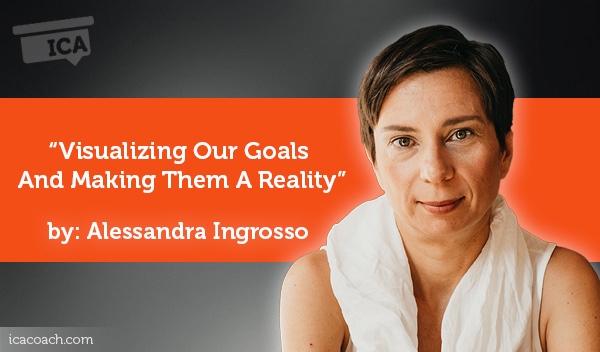
Research Paper By Alessandra Ingrosso
(Executive Coach, SWITZERLAND)

Dwell on the beauty of life. Watch the stars, and see yourself running with them. Marcus Aurelius, Meditations
Keeping an open mind is the key that allowed me to discover an effective tool to change my mindset and improve my life.
Usually a skeptic that visualizing a rosy future could have a positive effect on my life, I decided to have a leap of faith and give affirmations and visualizations a try. I was surprised at just how much simple affirmations thoughtfully repeated were able to change my thoughts and mood throughout the day. When I experimented with developing mental images of the elements in the affirmations that were especially important to me, I experienced how well these images were able to cement the positive thoughts into my mind and make them resonate through me and feel true. They have also allowed for a change of mindset where new things that I wanted in my life seemed possible and even probable.
What is positive psychology?
Positive Psychology is the scientific study of the conditions that contribute to the optimal functioning of people and that enable individuals to thrive1. Positive psychology does not deny the existence of suffering or aim at seeing things through pink-colored glasses but rather focuses on the study of what makes people feel joy and on how to promote human strengths to achieve individuals’ highest potential1,2.
On one side working on human strengths has the ability to make an ordinary life extraordinary; on the other, the study of strengths such as optimism has demonstrated that they represent protective factors for both psychological and physical health outcomes2,3. Optimism, a sense of personal control, and the ability to find meaning in life are resources associated with mental health and allow people to cope with difficult situations. It has also been demonstrated that positive thoughts can contribute to better health outcomes via the improvement of the immune system, better self-care, and better social relationships3. But what are the mechanisms that allow us to improve our lives by changing our thoughts?
Our mind constantly makes decisions on both small and big things. The activity in which the mind is engaged determines which brain circuits are utilized and which neural pathways grow. This is the process by which the mind literally creates the brain4. This hypothesis leads to the question: what happens when we use our mind to create the thoughts we want rather than let them flow randomly? The simple answer is that we are able to change our brain in a way that can improve our lives.
Our brain is an electromagnetic organ that emits different types of waves which can be picked up by EEGs. Gamma waves are produced when the brain learns, makes associations and integrates information, reflecting high level of intellectual function and heightened awareness. This is also the type of brain waves that have been found in experienced meditators. High beta waves occur in people experiencing frustration, stress or anxiety. These shut down the brain regions that handle critical thinking, decision making, memory and objective evaluation5. Each individual emits a combination of brain waves. When our consciousness and our emotions change, so do the brain waves we produce. Several studies have demonstrated that certain practices like mindfulness meditation or attention training can change the state of the brain to a healthier level of homeostasis. According to Dawson Church, brain waves also influence the way our cells replicate, thereby creating different connections and pathways in the brain and effectively creating a different brain!
If you want him to do it, you’ve got to change the picture of the world inside his head. Robert Penn Warren, All the King’s Men
Positivity tools
There are several tools in positive psychology that can support a change of perspective, change our thoughts and create or cement a positive outlook.
Affirmations are positive statements about an intention or something we would like to manifest in our reality. Studies have shown the benefits of affirmations in several areas of life. Affirmations allow individuals to reflect on sources of self-worth like core values thereby restoring a feeling of capability6,7. Also, it has been seen that self-affirmations improve working memory, problem solving under stress, and the ability to cope with everyday issues8,9. Affirmations have been shown to improve education, health, and relationships10.
The key starting point to reap the most benefit from affirming daily is to write about our values and things that are important to us, and state how those influence our attitude; then compose short positive statements that explain how we want to embody those values11. For example: ‘I am a courageous and resourceful woman and will be successful at all my undertakings today’; or ‘I focus on my intent and whenever my mind wonders away I immediately bring it back to what is good and constructive’.
I also observed that visualizing a specific scenario while self-affirming further changed my outlook and made that scenario feel real.
In general terms visualizing involves creating a mental image of a situation we would like to see materialized in the future, a state of being or a feeling we would like to achieve. Many professional athletes routinely use visualizations to learn new techniques faster and several studies have demonstrated the effectiveness of visualizations on outcomes such as students’ test performance. It has been demonstrated that visualizing ourselves successfully overcome an obstacle or reach a goal can help conquer fear and build self-confidence12. Our subconscious mind can’t differentiate between reality and imagination; and by using visualizations we can bypass limiting beliefs and fears to achieve our goals. In fact, it has been shown that when we visualize an action, the same regions of our brain are stimulated than when we actually perform it13. Visualizations can also help us focus our minds. Our reticular activating system (RAS) is a network of neurons in the brain that act as a filter determining which piece of information we notice from the environment. By visualizing our goals we can program our RAS to notice opportunities that will take us closer to achieving them12.
The act of visualizing involves the use of different brain regions with respect to the regions used for language. Traditionally the left side of the brain is regarded as the ‘logical’ area needed for language, and the right side the ‘creative’ one needed for imagination. When we visualize while at the same time affirming our goals or resolve, we involve different areas of our brain; thereby supporting a different way of learning, and cementing the changes we want to make in what can become a probable alternative reality.
How I use affirmations and visualizations in coaching
I use visualizations to support my clients to get through difficult or stressful situations. An example is a dreaded discussion with a supervisor at work. In this case I would ask clients to envision themselves in their boss’ office and ask questions that can support them to get through their fears. Example of questions are.
What do you want to say to yourself to prepare for this meeting?
What are you wearing for this meeting? What do you see?
How would you start the conversation?
Which words would you use to explain what is important to you about this situation?
I would then propose that they use this visualization in the days ahead of the event by summoning the single image and feeling that helps them most while affirming their values.
Some proponents of creative visualization believe that when we change our brain by choosing our thoughts we also allow for a process called ‘synchronicity’ that fosters a change in our material reality.
I can vouch for the power of visualizations on improving self-trust and mindset, and will continue to use them to keep myself motivated, seize opportunities and find my own inner resources to achieve my goals. I will also continue to keep an open mind, and if the stars of the universe choose to align, will take that as an added bonus!
A human being is a part of the whole called by us ‘Universe’, a part limited in time and space. He experiences himself, his thoughts and feelings as something separated from the rest – a kind of optical delusion of his consciousness…when we free ourselves from this prison…we can embrace all living creatures and the whole of nature. A. Einstein
References
1. https://ppc.sas.upenn.edu/
2. What (and Why) Is Positive Psychology? Review of General Psychology, Vol. 9, No. 2, 103-110
3. Optimism and Physical Health: A Meta-analytic Review. Ann Behav Med. 2009 June ; 37(3): 239–256. doi:10.1007/s12160-009-9111-x.
4. Mind to Matter: the astonishing science of how your brain creates material reality. Dawson Church
5. LeDoux JE (2002) Synaptic Self: How our brains become who we are. New York: Viking.
6. Beyond Self-Protection: Self-Affirmation Benefits Hedonic and Eudaimonic Well-Being. SK et al.
7. https://www.psychologytoday.com/intl/blog/embodied-wellness/201704/affirm-or-not-affirm
8. Self-affirmation improves performance on task related to executive functioning. J Exp. Social
Psychology. Miles et al. 70. 2017, 2018-285
9. Self-Affirmation Improves Problem Solving under Stress. Levine et al. Plos One 2013
10. Self-affirmation alters the brain’s response to health messages and subsequent behavior change. Strecher et al. PNAS 2015
11. 5 Steps to Make Affirmations Work for You. Learn how to make affirmations work for you. Ronald Alexander.
12. 4 Scientific Reasons Why Visualizations Will Increase your Chances to Succeed.
Accessed Jan 20, 2019
13. The Future of Memory: Remembering, Imagining, and the Brain. Szpunar et al. Neuron. 2012 Nov 21; 76(4)
14. Interactive Guided Imagery Therapy: